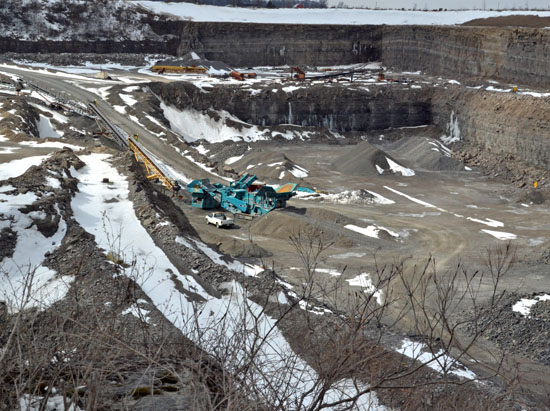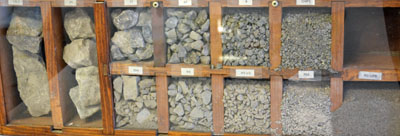Township-owned quarry 100 years old
DAVE MOSIER/independent editor
It’s been nearly a century since the Ridge Township trustees went into the quarry business. On Wednesday, the trustees celebrated the 100th year of the quarry with an open house at the Ridge Quarry site.

Current Ridge Township Trustee William Evans II said Ridge Quarry is the only township-owned quarry east of the Mississippi River, adding that Ridge Township is one of the few Ohio townships that actually generates revenue from a business venture.
The quarry came into being after township residents passed a levy in November 1913 raising $10,000 for the purpose of purchasing land and equipping a quarry. The township trustees at the time, J.S. Stuckey, James A. Uncapher and Joseph H. Ritchie, paid $3,547.50 for the land, which was purchased from Martha and Rose Johnson of Denver, Colo., and J.R. Morris of Yakima, Wash. A stone crusher was later purchased for approximately $5,000 and bins for the stone for approximately $1,000.
The trustees took possession of the land on August 1, 1914, with the quarry officially beginning operations in October 1915.
Not only does the quarry provide stone for Ridge Township roads, but for several county road operations as well, including Van Wert, Mercer and Allen counties in Ohio.
Ridge Township also purchased equipment in conjunction with neighboring Hoaglin and Jackson townships and uses quarry stone to chip and seal roads in the three townships. Other townships, including York and Jennings, while not doing roadwork themselves, purchase stone from Ridge Quarry to be used by the companies who do roadwork in those townships.
Larger stones dredged from the quarry also line the sides of Van Wert’s reservoirs, Evans noted, adding that those who buy Ridge Township limestone keep coming back for more.
“Customers like our stone, which is a blue limestone,” Evans said, adding that blue limestone is considered to be harder than the more typical brown limestone. “It’s a desirable product.”
Operating a quarry can be a challenge, although it also has its financial benefits. Evans said the quarry currently provides approximately two-thirds of the township’s annual revenues. A new stone crusher, purchased last year at a cost of approximately $600,000, will allow the quarry to produce even more stone. Even without the new equipment, quarry stone production has nearly doubled in the past 45 years, from 76,000 tons in 1968 to more than 132,000 tons in 2013. More importantly, the revenue from that stone has increased more than 10 times in the past four decades.
Like most quarries, though, keeping up with regulations is a full-time job. The Mine Safety and Health Administration – the same federal agency that regulates coalmines – also regulates quarries, with additional regulatory oversight coming from the U.S. and Ohio Environmental Protection Agencies.
“It’s a lot to keep up with the current regulations,” Evans said, noting that the township has spent a lot of time and money to ensure the quarry meets all necessary regulatory standards. “You have to be kind of bullheaded to have a stone quarry.”
Evans also commends the quarry’s seven employees – six full-time and one part-time – for the success of Ridge Quarry.
“They treat this like their own business, which is nice,” Evans said. “They’re great.”
Having the quarry revenues is definitely a positive, especially since the cost of paving roads has also increased substantially over the years.

Evans said asphalt costs alone average $66,000 a mile, and that’s after subsidies from the state. Chip and seal operations cost an average of $10,000 a mile, with the township having a total of 44 miles of roadway to deal with.
The purchase of the new stone crusher, and construction of a conveyor system by quarry employees has done a lot to decrease operating expenses at the quarry, Previously, trucks had to transport stone from the quarry floor to a crusher building farther up the quarry slope. With the new crusher, which sits on the quarry floor, and conveyor system, stone is transported all the way to the top of the quarry, eliminating the need for trucks in that portion of the operation. That cuts down expenses and the work involved, allowing the quarry to avoid replacing a couple of longtime employees who recently retired.
The limestone is processed into a variety of sizes and mixes, from large stones to stone ground down to nearly the consistency of sand.
In addition, the new equipment should allow the quarry to significantly increase its stone production.
“Before, we couldn’t keep up with the demand,” Evans said, noting that the quarry had to turn customers away because the quarry couldn’t mine stone fast enough.
Meanwhile, the benefits of owning a quarry continue to outweigh the negatives for township trustees – while township residents have also seen a decrease in some of the taxes they pay because of increasing revenues from the quarry.
Evans said trustees were able to scale back the amount needed for fire and EMS protection because of increasing revenues from the quarry.
“I think most township residents think the quarry is a good deal,” Evans said.
POSTED: 02/27/14 at 8:33 am. FILED UNDER: News







